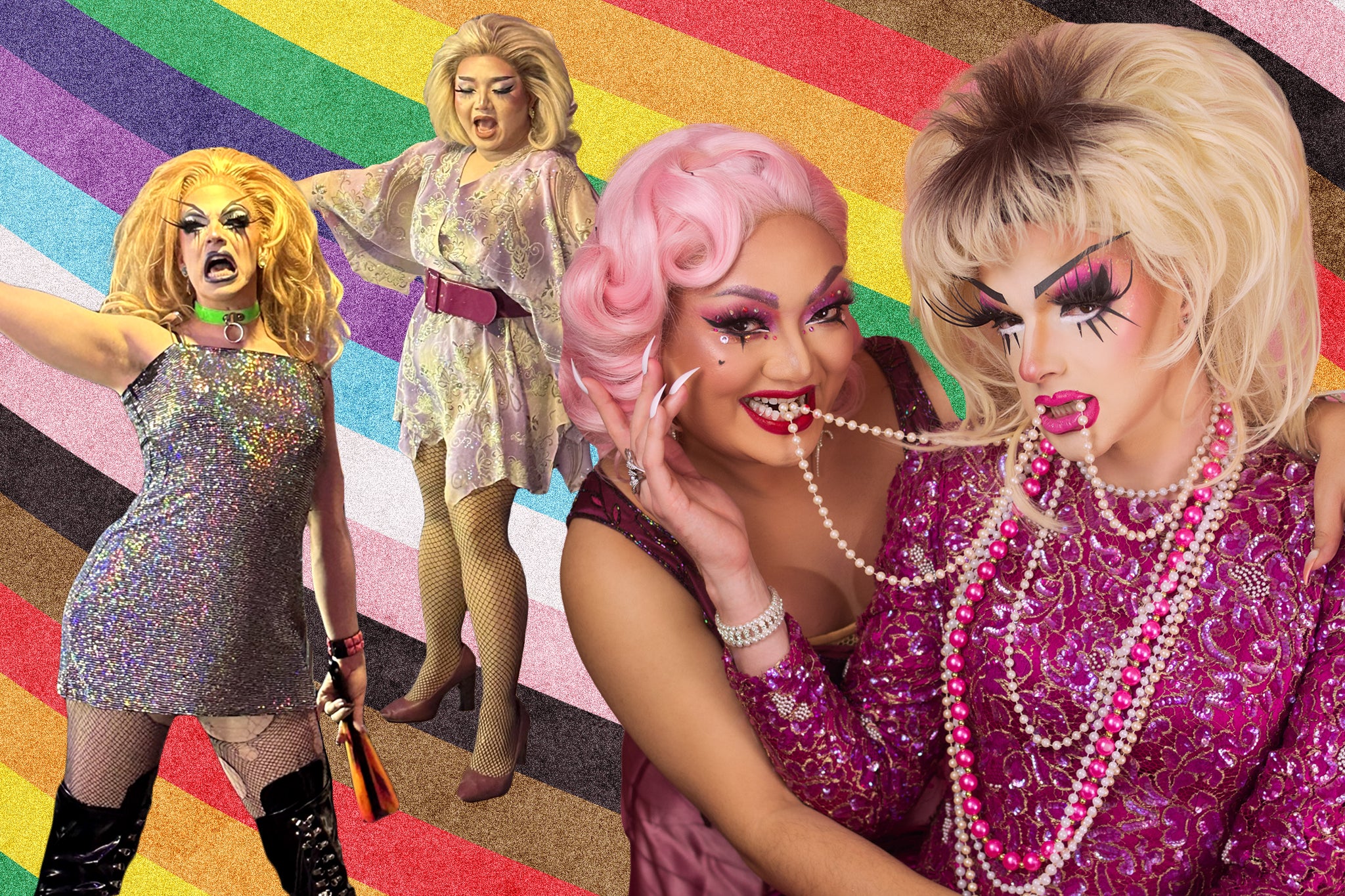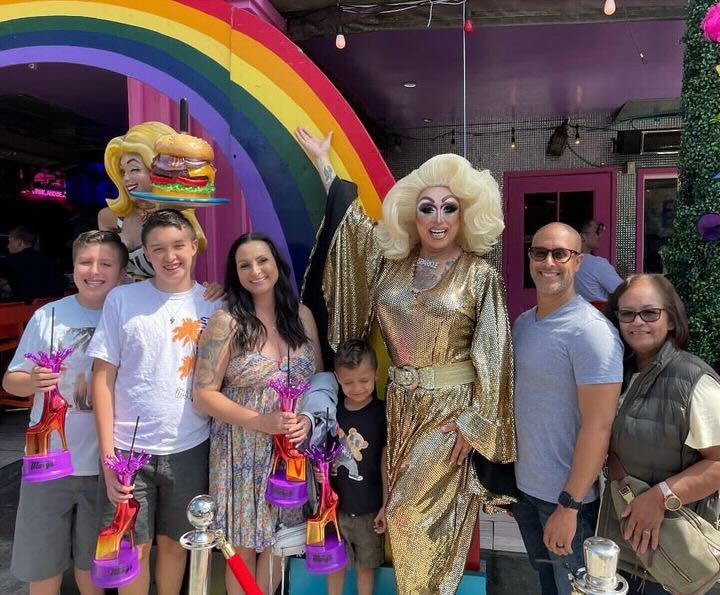Why mimosa-filled drag brunches continue to captivate queer audiences and allies
From show tunes to sashays, drag brunches have continued to spread joy among queer and non-queer people alike despite ongoing political crusades against performers. Meredith Clark and Olivia Hebert spoke to drag queens on opposite coasts, who shared how drag brunch continues to amplify local LGBTQ+ communities across the country


Your support helps us to tell the story
From reproductive rights to climate change to Big Tech, The Independent is on the ground when the story is developing. Whether it's investigating the financials of Elon Musk's pro-Trump PAC or producing our latest documentary, 'The A Word', which shines a light on the American women fighting for reproductive rights, we know how important it is to parse out the facts from the messaging.
At such a critical moment in US history, we need reporters on the ground. Your donation allows us to keep sending journalists to speak to both sides of the story.
The Independent is trusted by Americans across the entire political spectrum. And unlike many other quality news outlets, we choose not to lock Americans out of our reporting and analysis with paywalls. We believe quality journalism should be available to everyone, paid for by those who can afford it.
Your support makes all the difference.For bartender Justine Musselman – who’s worked at Dromedary: Coming Out in Bushwick, Brooklyn, for the past four years – the bar’s weekly drag brunch is the only reason she will wake up early on a Sunday. “I have been working at drag brunch for as long as I’ve worked at Dromedary, and despite the inconvenience of that shift, I refuse to give it up,” she told The Independent.
Every Sunday afternoon, drag performers Emi Grate and Nancy Nogood put their chemistry on full display for both Bushwick locals and visiting tourists at Dromedary’s drag brunch, where performances run the gamut from traditional show tunes to expert mashups.
Meanwhile, on the opposite coast, a drag queen named Jewels primps her voluminous blonde wig and hammily struts for a mimosa-addled crowd that whoops and shouts with glee as she puts on a show at a Hamburger Mary’s in Long Beach, California. Having performed at locations all across Southern California - including one of the franchise’s most popular locations in West Hollywood - drag has remained a long time passion for Jewels, who serves as the franchise’s director of entertainment.
The now-nationwide drag entertainment staple was introduced to Southern California in 2001, after beginning in San Francisco in 1972. At the time, the owners possessed nothing but a shoe-string budget and determination to see their vision of an “open air bar and grille for open-minded people.” Since those humble beginnings as an underground queer haven serving up Americana classics with a side of camp, the franchise has spread its gospel from Hawaii to Florida, capitalizing on an era in which drag is more popular than ever.
While the performance of drag is as old as time, it inarguably reached a wider, mainstream audience 15 years ago with the advent of RuPaul’s Drag Race. The competition-style series has since made A-list celebrities out of its drag queen contestants, with stars like Trixie Mattel and Katya dominating the comedy podcast sphere and Bianca Del Rio selling out concert halls across the globe. The performances have come a long way from the vaudeville cross-dressing of the 1880s, or the drag ball subculture of the 19th and 20th centuries. Now, drag brunches occupy restaurants and outdoor venues like parks, festivals, and entire street corners.
“The public has always been fascinated, titillated, and excited by drag and cross-gender performances, so once RuPaul’s Drag Race hit the airwaves and established itself as this obsession, people began to look to see live drag performance,” Joe E Jeffreys, drag historian and professor of theater studies at New York University’s Tisch School, told The Independent.

The weekly ritual of brunch has often been the subject of derision from older generations, who famously mocked millennials years ago for their supposed fascination with avocado toast. Nevertheless, brunch culture has remained a force in major US cities, where the entire group chat takes part in a fixed-rate bottomless mimosa offering. The term “brunch” was coined by British writer Guy Beringer in an 1895 article in Hunter’s Weekly, titled “Brunch: A Plea”. In the essay, he argued for brunch – a combination of breakfast and lunch – to be incorporated in our weekly routine. “Dinner’s the thing; the hour between seven and eight is worth all the rest put together,” Beringer wrote. “Brunch, on the contrary, is cheerful, sociable, and inciting. It is talk-compelling. It puts you in a good temper; it makes you satisfied with yourself and your fellow beings. It sweeps away the worries and cobwebs of the week.”
That’s why pairing the delight of brunch with the excitement of drag comes as no surprise. Lips, originally co-founded in Greenwich Village by Yvonne Lame, has now been operating in New York City for more than two decades, sparking a drag dining empire with several locations across the country. Lucky Cheng’s, established in 1993, began entertaining the public with drag brunch in 2019 and has since been consistently voted the best drag brunch in the Big Apple.
At Dromedary: Coming Out, becoming a collectively-run queer space wasn’t always the goal when it opened in 2016 under the ownership of Michael Lombardozzi. When he turned his focus toward his newer businesses in the Bushwick area, several bartenders at Dromedary – then a tiki bar on Irving Avenue – decided to take over and cheekily rename it Dromedary: Coming Out. Its owners brought back the fan-favorite drag brunch, which holds the coveted title of longest-running drag brunch in Brooklyn, and began hosting more community-focused weekday events, such as housing rights workshops.

“It’s always accidentally been a queer bar – with obviously our drag brunches and drag shows, with the employees who worked there mostly being queer, with the Bushwick location and just the community that found itself there,” said Musselman. “When we all decided to start running the space together, we were like: ‘Let’s lean into the community that’s really found a home here,’ and we decided to make it a very intentionally queer space.”
Emi Grate, who’s been performing at Dromedary every weekend since early 2019, describes the bar’s drag brunch as organized chaos. “There is a method to the madness,” she told The Independent about her weekly drag brunch with Nancy Nogood. Despite being from different countries – Emi is originally from Mandalay, Burma, and Nancy is from South Carolina – it’s their shared interests that balance each other on stage. “They know how to push each other’s buttons and you get to witness them do really beautiful performances, but also banter and there’s a lot of fun audience interaction, which I think is special to drag brunch,” said Musselman. “I know a lot of shows incorporate audience participation but I think with drag brunch specifically, there’s this energy of family – almost like we’re all having brunch together.”
Much of the appeal of drag brunch is the accessibility it provides for both the queer community and its allies. For those who work late shifts, or are just turned off by nightlife entirely, drag brunch offers the opportunity to experience the art form in a daytime setting. Some people may be curious about drag, yet too intimidated to attend a late-night drag show. With its more accommodating daytime spot, the event opens up drag performance to a wider audience. At Dromedary, customers have even shared that they feel more comfortable bringing their parents to drag brunch than other queer-focused events.
“Drag brunch replaces drag performance in a more conducive atmosphere for many people,” said Jeffreys. “It puts it in the middle of the day and at a restaurant space that they may be familiar with. They may have never been to a gay bar, but they’ve been to a restaurant. It answers a lot of the questions and concerns that some people may have about attending so-called traditional drag performance.”
Some drag performances also have themes that make the experience more accessible to the average attendee, with West Hollywood’s Hamburger Mary’s joint taking familiar characters like Disney princesses or the Wizard of Oz and turning it into drag gold. The franchise particularly advertises Sunday mornings as a “Brunch with the Brunchettes” – a revolving door of regular performers including Sparkle Stone and Miss Luna, both of who describe their weekly drag brunches as a way to get in touch with their inner child.
The latter of the two – proud Nicaraguan Miss Luna - said: “It’s like being a kid all over again, but this time playing make believe with really pretty and awesome costumes and props. You truly can be anything you want to be.”
She has performed from New York City to Hamburger Mary’s locations all across Southern California, finding the diner to be a safe haven where she can freely embrace her inner popstar. When she’s not performing as a Brunchette, she’s bringing the house down as a drag version of the late-Chicana artist Selena, performing hits like “Bidi Bidi Bom Bom” with gusto.

However, it’s not just the freedom of self-expression that’s drawn Luna to drag, but also the positivity and love she receives from the crowd. These weekly shows have both their regulars and fans, with 24-year-old Tessa Hughes being one of them. “There’s never a moment when I’m not smiling,” Hughes said, noting that she’s visited the venue for years. “The queens they hire are absolutely fantastic and hilarious and really cultivate a fun vibe for guests.”
She added: “Drag is an art that takes talent, passion, dedication, and love and I wish that was appreciated more.”
Drag has long been a solace for the LGBTQ+ community, acting as an avenue for uninhibited self-expression that was not only frowned upon in the past, but could even endanger their livelihoods if publicized. Despite achieving mainstream success, drag’s current popularity has become a double-edged sword in the public eye. In the past few years, drag performers have faced frequent backlash in red states, where some conservative groups lambast performers and venues hosting them as hotbeds of sin.
After a 2017 InfoWars segment from far-right commentator and conspiracy theorist Alex Jones specifically called out San Francisco non-profit Drag Story Hour, making baseless allegations that drag performers were groomers trying to have “their way” with children, there was a similar public outcry from conservatives. States like Tennessee, Texas, and Montana took advantage of the backlash and passed legislation that banned drag performances in public spaces last year.
“It’s all for political gain, it’s people using church and politics to scare people and keep communities oppressed as they have done with other minorities for years, nothing has changed. No one is here to turn your child into a drag queen!” Sparkle Stone told The Independent. “They use children as a ploy to scare the public into a fright. I’m very thankful I live in Los Angeles and not in a small town where drag was closed down or taken away for political gain.”

The ongoing conservative crusade against drag performers has been frightening to watch unfold, but it comes as no surprise to those who have been in the game for a while. Even with pop culture touchstones like RuPaul’s Drag Race serving as a beacon of positive representation, some drag queens feel like the backlash was inevitable.
“Even as Drag Race continues to grow, the local scenes are coming under attack from politicians, far right groups, the economic structure,” Grate noted. “We’re entering another downhill dip moment.”
Despite this, she urged drag performers to continue on in the face of the onslaught of far-right propaganda and attacks. By doing so, Grate believes that drag performers can change hearts and minds by staying committed to their artistry and not backing down in the face of bigotry.
“I am personally embracing being a local artist who can be present in the world, consistently in the community for everyone to come see and experience the culture in its own space,” she said. “You can come see us in our element as we are. That, I personally believe, is the value of the show that we do consistently on Sundays.”
On the outside, drag brunch may appear to some as simply an excuse to get tipsy during the day and belt out show tunes. Really, drag brunch provides the opportunity for both LGBTQ+ individuals and allies to amplify the performance art that’s happening in their local community.
“Drag is the indigenous queer performance form,” said Jeffreys. “It’s of the people, by the people, and for the people. Drag brunch helps put it out there for everyone, and just furthers that celebration.”
Join our commenting forum
Join thought-provoking conversations, follow other Independent readers and see their replies
Comments